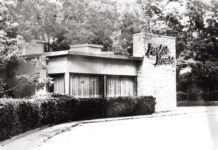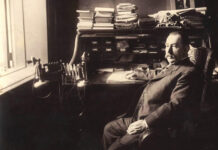
Rusted, stained, gutted and paint peeling, but still grand, the SS United States glided past Sand Island Light house into Mobile Bay early on the morning of March 3. Towed by the powerful Vinik No. 6 tugboat and nudged by several squat harbor craft, she advanced towards the Port City as hundreds of excited people watched. Prompted by extensive press coverage, social media posts and good old-fashioned word of mouth, some had waited hours for the historic event. From Dauphin Island and Mobile Point to the Eastern Shore, the Causeway and downtown Mobile, they all grasped its significance — the SS United States represented the pinnacle of American maritime design and engineering, an impressive if faded ocean relic redolent of mid-century glamour, celebrity and class. Mobile-bound for preparation as an offshore fishing and diving reef, she would soon slip beneath the waves for all time. Contemplating her stylish lines and raking smokestacks, just about everyone expressed some variation of the same sentiment: “Too bad she can’t be saved.”
While the United States remains in Mobile, possibly for months to come, many will see her distinctive profile on the downtown waterfront and wonder about her history. As one might guess, it is a saga filled with larger-than-life personalities and monumental achievements. The ship’s genesis dates to November 12, 1894. On that day, the parents of William Francis Gibbs, or W. F. as he always called himself, took their 8-year-old son to Philadelphia to witness the launch of a brand-new passenger ship, the SS St. Louis. As young W. F. watched, First Lady Frances Cleveland smashed a champagne bottle against the ship, after which it slid down the ways with a loud metallic groan, hitting the water with a prodigious splash. Mesmerized, W. F. resolved to design and build such marvels himself. His father had different ideas, however, and pushed his son into law school. W. F. graduated from Columbia in 1913, and in deference to his father, practiced for two years. Not surprisingly, he hated it. He spent his spare time studying ship design and construction. He clearly had a gift and got so good that he managed to apprentice himself to a prominent naval architect, after which he and his brother, Frederick, founded their own company, Gibbs Brothers, Inc., and even gained financial backing from J.P. Morgan.
Fortunate in their historical moment, Gibbs Brothers flourished, designing reliable, fast and safe passenger ships like the SS Malolo (1924), accidentally rammed by another ship during her sea trials but not sunk despite a gaping hole, and the SS America (1940). During World War II, the brothers teamed with naval architect Daniel H. Cox and renamed the firm Gibbs and Cox. During the war they turned out thousands of merchant vessels as well as tankers, minesweepers, destroyers and liberty ships. Despite these significant achievements, W. F. yearned to build a passenger ship equal to the nation’s greatness.
He got the opportunity after the war when he and Frederick convinced the Department of Defense to subsidize construction of a 1,000-foot ocean liner easily convertible into a troopship capable of carrying a full infantry division. Thanks to the emergent Cold War, the plans quickly advanced, and by 1950, workers at Newport News Shipbuilding in Virginia laid the keel of the SS United States. Guided by reams of W. F.’s blueprints, hustling men and women assembled the ship entirely in drydock under the strictest secrecy. W. F. closely managed every detail, often to the workers’ chagrin (once a shipyard owner locked the gates when the designer appeared unannounced). Finally, after 28 months of feverish activity, the secrecy ended, and W. F. opened his dream ship to public inspection.
Everyone was dazzled. The gleaming new $79 million ship measured 990 feet in length (108 feet longer than the Titanic), 101 feet wide (slightly narrower than the Panama Canal) and 175 feet from keel to funnel top. She displaced 45,400 tons and featured a fireproof aluminum superstructure and a thick steel hull fully hand-sanded below the waterline to reduce drag. W. F. so emphasized fire safety that the only wooden items on board were the butcher blocks and Steinway pianos. According to a Popular Science magazine article at the time: “Fabrics and wall finishes run the whole spectrum, but both fabrics and paints are fire-retardant. Furniture is aluminum; upholstery and cushions are springy and soft but they are filled with a new material that will not flame.” Native American and aquatic design themes predominated with lots of reds, blues, greens and golds.
Driven by diesel-powered steam boilers, the United States’ four massive manganese-bronze propellers each weighed 60,000 pounds and could deliver astonishing speeds of 35 knots (40 miles an hour) and more moving forward and 20 knots in reverse. Contemplating his creation, W. F. remarked that the many men and women who had built the ship “knew what they were doing. They knew that they were trying for the greatest ship in the world, and they knew they were doing it as trustees for the citizens of the United States.” Proud of the new vessel, he boasted, “You can’t set her on fire, you can’t sink her and you can’t catch her.”



Compared to modern cruise ships with their passenger capacities in the thousands, the United States was a modest vessel. Crewed by 900 men and women, she could carry 1,900 passengers divided into first, cabin and tourist classes. Her amenities included a ballroom, a theater, smoking rooms, lounges, beauty parlors, dining rooms and a swimming pool. To meet daily passenger needs, her sundries included 125,000 pieces of china; 7,000 bedspreads; 4,000 blankets; 81,000 face towels; and seven caskets in the infirmary. Before every departure, her kitchens stocked 1,100 pounds of prime rib; 15,000 pounds of poultry; over 12,000 quarts of milk; 8,000 quarts of ice cream; 5,800 dozen eggs, a ton of cheese; and 500 pounds of caviar.
During the ship’s sea trial with 500 lucky passengers on board, W. F. Gibbs’ wife, Vera, recorded her impressions. She knew better than anyone the innumerable challenges her husband had faced during construction, and she marveled at the finished product. “One room had black walls with brilliant diamond stars of illuminated glass,” she wrote. “I thought they were magnificent snowflakes, but no, they were heavenly bodies. The ballroom was a triumph. Between the bar and the dance floor were glass screens, pure crystal, engraved with the most exquisite designs.” She described “unusually attractive vases of mixed flowers on every table, really a most charming variety,” and praised a “model of the ship, about three feet long, in sugar, which was conspicuously placed and lighted in the dining salon.” Overall, she gushed, the ship “seemed like a fairy palace,” and she “forgot all the headaches it had taken to build her.”
At last, on July 3, 1952, the United States departed New York on her first Atlantic crossing. Among the passengers were Margaret Truman, President Harry Truman’s daughter, and Vincent and Mary Astor. People expected that the new ship would break the standing speed record held by the Queen Mary and capture the coveted Blue Riband. W. F. Gibbs kept the bridge with the captain, Commodore Harry Manning, as the ship passed Ambrose Light and gained speed. Manning had to slow the vessel when a thick fog bank appeared, but then quickly powered back up, and on day two, the United States was breasting boisterous seas and gale-force winds. A few brave souls ventured onto the open deck but quickly hurried back inside.

Despite the free first-class passage provided him (a $360 value, or $4,287 today), the London Daily Mail’s Don Iddo expressed disappointment. He grumbled that there were not more celebrities on board and complained that the ship rolled too much. Nor did he like the spare, mid-century design aesthetic, devoid of wood or elaborate flourishes. “It is ultra-modern,” he huffed, “a big chromium air-conditioned streamlined Park Avenue apartment house afloat.”
Most everybody else enjoyed themselves, however. When the ship darted past Bishop Rock Lighthouse, Cornwall, on July 7 after only 3 days, 10 hours, and 40 minutes — beating the Queen Mary’s record by 10 hours — spontaneous parties erupted all over the ship. Vera Gibbs exulted: “The Meyer Davis Orchestra had come up on deck, having played the whole night through. There was dancing, singing and finally a snake dance up and down the deck. Everyone danced with everyone else. One man was offering any woman he saw a swig from his bottle.” Prime Minister Winston Churchill telegraphed hearty congratulations, and 20,000 cheering Britons greeted the ship when she docked at Southampton.
During her short 17-year career under the aegis of United States Lines, the vessel garnered the admiring monikers of “The Big U” and “America’s Flagship.” She made a total of 400 transatlantic round trips and carried numerous well-known personalities, including President John F. Kennedy, Ethiopian Emperor Haile Selassie, Princess Grace Kelly, Greta Garbo, Sean Connary, Cary Grant, John Wayne, Bob Hope, Marilyn Monroe and the Duke and Duchess of Windsor. By 1969, cheap and efficient air travel trumped oceanic passenger liners, and the United States went out of business. Fortunately, W. F. Gibbs, who had died two years earlier, did not live to see the day.
The United States passed through several different owners in the following years. Ambitious plans to convert her into a casino, a deluxe passenger ship, condominiums or a hotel all came to naught. In 1984, her then-owner, Seattle millionaire Richard Hadley, auctioned off all her appointments, including the interior furnishings, deck chairs, crew uniforms, towels, tablecloths and china. In 1992, her new Turkish owner had her towed to Sevastopol, Ukraine, for asbestos removal and eventual restoration. Unfortunately, the asbestos removal costs broke him, rendering him unable to pay his creditors in the States, so U.S. Marshals seized the vessel and had her towed to Philadelphia where she remained docked for 28 years. Despite heartfelt efforts by the SS United States Conservancy, which acquired her in 2011, the ship continued to deteriorate. In 2021, the owner of the ship’s Philadelphia pier raised the rent and then evicted her. During litigation, a judge gave the Conservancy 90 days to find an alternative site. After further delays and stress, the Conservancy finally sold the United States to Okaloosa County, Florida, last October for $1 million. Okaloosa County plans to spend $10 million preparing and sinking the vessel for an offshore reef. Hence came the United States’ long tow into the Port of Mobile.
While many people consider this a sad end, the challenges and costs of fully restoring the United States are wildly impractical. Many have already tried, to the tune of millions of lost dollars. Rather than mourn the ship’s fate as a fishing and dive reef, some will consider it a viable new phase. As soon as her elegant hull comes to rest on the sandy Gulf floor, dive charters and anglers will flock to the site. Thousands of people will experience the SS United States in an in an exotic new way. The underwater pictures and videos should be stunning and compelling reminders of W. F. Gibbs’ epic achievement.
John S. Sledge is the co-author of “Mobile and Havana: Sisters Across the Gulf” and has produced seven other books of local history.





